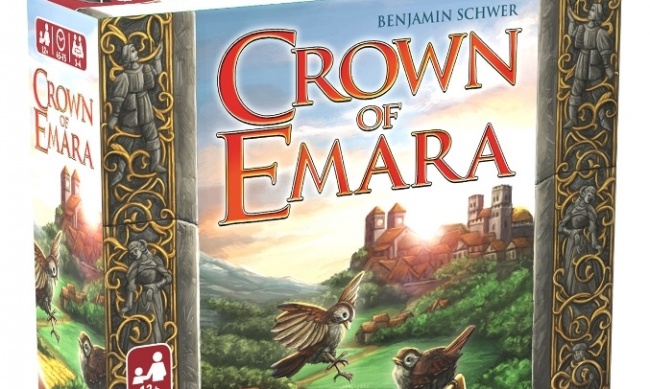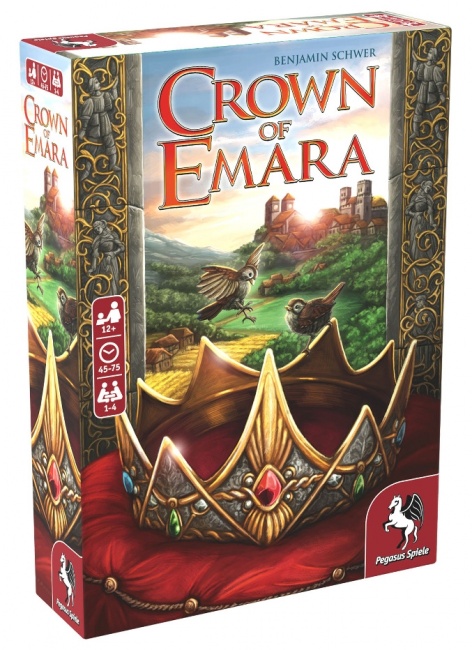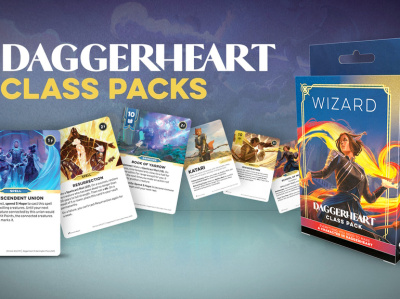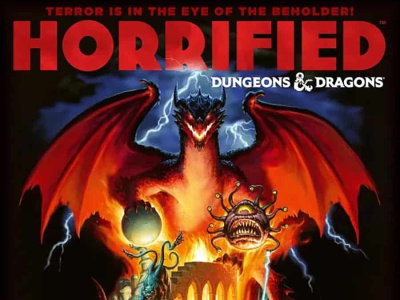Crown of Emara
Publisher: Pegasus Spiele
Release Date: August 2019
MSRP: $49.99
Creators: Benjamin Schwer (Designer), Dennis Lohausen (Illustrations)
Number of Players: 1 – 4
Playing Time: 45-75 mins.
Age Rating: 12+
ICv2 Rating: 4 Stars out of 5
There are a lot of games about building up medieval towns and kingdoms; it’s something most experienced boardgamers are familiar with. But it’s pretty rare that we are expected to concern ourselves with the well-being of our fictitious subjects. This is the departure point for Crown of Emara: it is not enough to gather the most points, represented by the citizens of our feudal province, we must also see that they are comfortably housed as well. But does the game take as much care to make sure that the players are comfortably taken care of as well?
Summary: In Crown of Emara, the King Theodorius has challenged up to four would-be successors to prove their worth as rulers by giving the citizens the right to flock to the noble who most appeals to them. Appeal is gained by providing the people with food, seeing to their education, attracting advisors from around the kingdom, and acquiring prestigious rank. But it is not enough to gather many citizens to your cause, you must also supply them with housing. At the end of the game, you count only the lower value between your citizens and your buildings.
In classic resource management style, these feats are all accomplished by collecting the proper combinations of resources and spending them at the right time to purchase favors from the king, learning from the church, advisors, titles, and other goods. Game play takes place on two independent boards in "rondel" fashion, with movement allowed in only one direction and the space one lands on determining what actions they may take that turn. One board provides resources, while the other determines what you can spend them on. Each turn, a card played from a dwindling hand dictates how many spaces you must move, but you choose which board to move on. After 18 such turns, the game ends and the player with the most points (citizens or buildings) wins the game and becomes the next ruler of Emara.
Originality: What appeals to me in Crown of Emara is not any innovative mechanics or themes, but the way that seemingly unrelated mechanics fit together into a coherent whole. We have seen resource management games set in the Middle Ages. The rondel mechanic is not revolutionary. The hand management element has been seen before. But pulling these together creates some surprising twists: the card you play each turn determines not only your movement on the board, but also half of the actions you can take that turn, and much of the strategy in the game arises from combining the board actions and the card actions effectively. This, I think, is quite clever.
Presentation: Lohausen’s artwork for the game is effective and very pleasing to the eye. Just looking at the cover with its pair of cavorting titmice frolicking around the crown makes it clear that this is not a game about conflict or war, but rather a peaceful competition. The player boards sport male and female characters on opposite sides, respectfully allowing each player to express their preferences. The iconography is clear and easy to understand. The overall effect is pleasant and comforting, befitting the theme of the game. The back of the box shows off the components well and provides a deceptively simple three-part description of how the game is played.
Quality: Crown of Emara continues the long tradition of solidly-manufactured "Euro" games. The box is strong and appropriately sized, with a nice linen finish. The cards are good, thick material. The abundant wooden pieces feel nice in the hand and look good on the table. The tiles are thick and high quality, as are the boards, which are modular in design for greater variability of play. The rules are clear and well-illustrated, though I think they would have benefited from having more examples of play and a few rules could have been highlighted better. However, the game’s complexity is low enough that there should be no real obstacles to learning how to play.
Marketability: Resource management type games may be a crowded field, but I believe that it is still a genre that has room for growth and interesting new ideas if they are packaged and presented well, and Crown of Emara has all of those things. Euro-style boardgames continue to be popular, and the competition without conflict approach can appeal to a broad audience, from casual family-friendly players to more serious tacticians. The game box has a comforting "heft," and both gameplay and component quality justify the price.
Overall: Sometimes, you read the rules for a game, and everything seems clear and straightforward. Then, when you start to play, you realize that it is a lot deeper than you were expecting. Crown of Emara is that kind of game. The game mechanics and rules are not complex, but there is an emergent depth to the game that comes from the way the mechanics interact with each other.
Playing the game well requires players to balance a number of different elements, and every decision impacts the game in multiple ways. While 18 turns seems like a lot, the game moves quickly, and careful planning is crucial to developing strategies over the long term. The result is a solid but accessible middleweight strategy game that rewards clever play without excessive length. And that’s why I’m giving this game 4 out of 5.
-Will Niebling

ICv2 Stars: 4 (out of 5)
Posted by William Niebling on August 15, 2019 @ 12:24 am CT
MORE GAMES
Class-Specific Card Decks for 'Daggerheart' RPG
August 6, 2025
Darrington Press has announced plans to release a series of nine Class Packs for use with its Daggerheart role playing game.
Coming to Kickstarter Soon
August 6, 2025
Catalyst Game Labs, Toho, and Crunchyroll have teamed up to produce My Hero Academia Miniatures Game.
MORE REVIEWS
ICv2 Stars: 3.5 (out of 5)
July 30, 2025
Here is a review of Ravensburger's Horrified: Dungeons & Dragons.
ICv2 Stars: 3.5 (out of 5)
July 24, 2025
Check out the review of Disney Villainous: Treacherous Tides, from Ravensburger.








